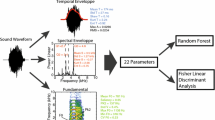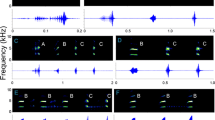Summary
Several species of frogs of the subgenusRana (Paa) and one species of bird of the genusPhylloscopus, which are calling in or near torrents in the Himalayas, show striking similarities in their vocal signals: 1) The calls are composed of short sequences of notes separated by periods of silence; 2) the notes are pure, short, and have a narrow frequency band; 3) within each sequence, the notes are rhythmically emitted. We suggest that these characteristics may be adaptive, the convergence being caused by the selective pressure of the acoustic constraints of the biotope.
Zusammenfassung
Mehrere Frosch-Arten der UntergattungRana (Paa) und ein Laubsänger der GattungPhylloscopus, die in oder in unmittelbarer Nähe von Gebirgsflüssen des Himalayas leben, weisen in ihren akustischen Signalen bemerkenswerte Ähnlichkeiten auf. 1) Die Rufe bzw. Gesänge setzen sich aus kurzen Folgen von Elementen zusammen, die durch lange Pausen getrennt sind. 2) Die Elemente sind rein und kurz; ihre Frequenzbänder sind schmal. 3) Innerhalb jeder Ruffolge werden die einzelnen Elemente rhythmisch geäußert. Wir vermuten, daß diese Eigenschaften adaptiv sind. Derart ähnliche Rufe bei nur weitläufig verwandten Tiergruppen würden somit auf Konvergenz beruhen, hervorgerufen durch den Selektionsdruck der akustischen Eigenschaften des Biotops.
Similar content being viewed by others
Literature
Amiet, J.-L. (1974): Voix d'Amphibiens camerounais. IV. Raninae: genresPtychadena, Hildebrandtia etDicroglossus. Ann. Fac. Sci Cameroun 18; 109–128.
Bates, R. S. P. &E. H. N. Lowther (1952): Breeding birds of Kashmir. Oxford Univ. Press, Bombay.
Bergmann, H.-H. &H.-W. Helb (1982): Stimmen der Vögel Europas. BLV Verlagsges., München.
Chappuis, C. (1971): Un exemple de l'influence du milieu sur les émissions vocales des Oiseaux: l'évolution des chants en forêt équatoriale. Terre et la Vie 25; 183–202.
Dorka, V. (1976): Beobachtungsnotizen zum Nestbau- und Lautverhalten eines Pyrenäen-MauerläufersTichodroma muraria. Anz. orn. Ges. Bayern 15: 202–215.
Dubois, A. (1975a): Un nouveau sous-genre(Paa) et trois nouvelles espèces du genreRana. Remarques sur la phylogénie des Ranidés (Amphibiens, Anoures). Bull. Mus. natn. Hist. nat. (3) 324 (Zool. 231): 1093–1115.
Ditto (1975b): Un nouveau complexe d'espèces jumelles distinguées par le chant: les Grenouilles du Népal voisines deRana limnocharis Boie (Amphibiens, Anoures). C. r. Acad. Sci. (D) 281: 1717–1720.
Ditto (1976): Les Grenouilles du sous-genrePaa du Népal (famille Ranidae, genreRana). Cah. nép. Doc., Paris, C.N.R.S. 6: 1–275.
Ditto (1977a): Chants et écologie chez les Amphibiens du Népal. In: Himalaya. Écologie-Ethnologie, Colloques internationaux du C.N.R.S. N° 268, Paris, C.N.R.S.: 109–118.
Ditto (1977b): Observations sur le chant et les relations interindividuelles chez quelques Grenouilles du sous-genrePaa du Népal (Amphibiens, Anoures, genreRana). Bull. Soc. zool. France 102, suppl. 2: 163–181.
Duellman, W. E. (1967): Social organization in the mating calls of some neotropical Anurans. Amer. Midl. Nat. 77: 156–163.
Eibl-Eibesfeldt, I. (1967): Grundriß der vergleichenden Verhaltensforschung. Ethologie. Piper & Co., München.
Fleming, R. L., R. L. Fleming &L. S. Bangdel (1976): Birds of Nepal, with reference to Kashmir and Sikkim. Kathmandu.
Gaston, A. J. (1974): Adaptation in the genusPhylloscopus. Ibis 116: 432–450.
Günther, R. (1969): Paarungsrufe und reproduktive Isolationsmechanismen bei europäischen Anuren der GattungRana (Amphibia). Forma et Functio 1: 263–284
Heyer, W. R. (1971): Mating calls of some frogs from Thailand. Fieldiana Zool. 58: 61–82.
Jilka, A. &B. Leisler (1974): Die Einpassung dreier Rohrsängerarten in ihre Lebensräume. J. Orn. 115: 192–212.
Koenig, O. (1952): Ökologie und Verhalten der Vögel des Neusiedlersee-Schilfgürtels. J. Orn. 93: 207–289.
Kuramoto, M. (1977): Mating call structures of the Japanese pond frogs,Rana nigromaculata andRana brevipoda (Amphibia, Anura, Ranidae). J. Herpet. 11: 249–254.
Leroy, Y. (1977): Convergences sonores. Référence aux vocalisations des Amphibiens Anoures. Bull. Soc. zool. France 102, suppl. 2: 203–215.
Ditto (1979): L'univers sonore animal. Gauthiers-Villars, Paris.
Löhrl, H. (1964): Verhaltensmerkmale der GattungenParus (Meisen),Aegithalos (Schwanzmeisen),Sitta (Kleiber),Tichodroma (Mauerläufer) undCerthia (Baumläufer). J. Orn. 105: 153–181.
Ditto (1976): Der Mauerläufer. Neue Brehm-Bücherei 498. Ziemsen, Wittenberg.
Marler, P. (1955): Characteristics of some animal calls. Nature 176: 6–8.
Ditto (1959): Developments in the study of animal communication. In:P. R. Bell (ed.), Darwins's biological work, 150–206. Cambridge Univ. Press, Cambrige.
Marten, K. &P. Marler (1977): Sound transmission and its significance for animal vocalization. I. Temperate habitats. Behav. Ecol. Sociobiol. 2: 271–290.
Martens, J. (1980): Lautäußerungen, verwandtschaftliche Beziehungen und Verbreitungsgeschichte asiatischer Laubsänger(Phylloscopus). Fortschr. Verhaltensforsch. 22: 1–71.
Mecham, J. S. (1971): Vocalizations of the leopard frog,Rana pipiens, and three related Mexican species. Copeia 1971: 505–516.
Menzies, J. I. &M. J. Tyler (1977): The systematics and adaptations of some Papuan microhylid frogs which live underground. J. Zool., Lond. 183: 431–464.
Morton, E. S. (1975): Ecological sources of selection on avian sounds. Amer. Nat. 109: 17–34.
Niethammer, G. (1952): Zur Anatomie und systematischen Stellung der Sturzbach-EnteMerganetta armata. J. Orn., 93: 357–360.
Pace, A. E. (1974): Systematic and biological studies of the leopard frogs (Rana pipiens complex) of the United States. Misc. Publ. Mus. Zool. Univ. Mich. 148: 1–140.
Passmore, N. I. &V. C. Carruthers (1979): South African frogs. Witwatersrand Univ. Press, Johannesburg.
Schubert, G. &M. Schubert (1969): Lautformen und verwandtschaftliche Beziehungen einiger Laubsänger(Phylloscopus). Z. Tierpsychol. 26: 7–22.
Schubert, M. (1976): Das akustische Repertoire des Fitislaubsängers(Phylloscopus t. trochilus) und seine erblichen und durch Lernen erworbenen Bestandteile. Beitr. Vogelkde. 22: 167–200.
Ditto (1982): Zur Lautgebung mehrerer zentralasiatischer Laubsänger-Arten (Phylloscopus; Aves, Sylviidae). Mitt. Zool. Mus. Berlin 58: 109–128.
Shalter, M. D. (1978): Localization of Passerine Seeet and Mobbing calls by Goshawks and Pygmy Owls. Z. Tierpsychol., 46: 260–267.
Shalter, M. D. &W. M. Schleidt (1977): The ability of Barn OwlsTyto alba to discriminate and localize avian alarm calls. Ibis 119: 22–27.
Stadler, H. (1926): Stimmenbiotop und Melozönosen. Ber. Ver. schles. Orn. 12: 95–96.
Thielcke, G. &K. E. Linsenmair (1963): Zur geographischen Variation des Gesanges des Zilpzalps,Phylloscopus collybita, in Mittel- und Südwesteuropa mit einem Vergleich des Gesanges des Fitis,Phylloscopus trochilus. J. Orn. 104: 372–402.
Ticehurst, C. B. (1938): A systematic review of the genusPhylloscopus (Willow-warblers or Leaf-warblers). Brit. Mus., London.
van Gelder, J. J., P. M. G. Evers &G. J. M. Maagnus (1978): Calling and associated behaviour of the common frog,Rana temporaria, during breeding activity. J. anim. Ecol. 47: 667–676.
Vencl, F. (1977): A case of convergence in vocal signals between marmosets and birds. Amer. Nat. 111: 777–782.
Voous, K. H. (1977): List of recent Holarctic bird species. Passerines. Ibis 119: 223–250.
Author information
Authors and Affiliations
Additional information
Dedicated to Ernst Mayr on the occasion of his 80th birthday
Results of the Himalaya Expeditions ofJ. Martens, No. 108. — No. 107: Reichenbachia, 22 (1), 1984. — J. M. sponsored by Deutscher Akademischer Austauschdienst and Deutsche Forschungsgemeinschaft.
Rights and permissions
About this article
Cite this article
Dubois, A., Martens, J. A case of possible vocal convergence between frogs and a bird in Himalayan torrents. J Ornithol 125, 455–463 (1984). https://doi.org/10.1007/BF01640137
Published:
Issue Date:
DOI: https://doi.org/10.1007/BF01640137




